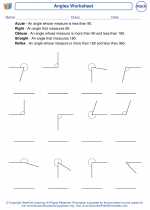Angles
An angle is a measure of rotation between two rays that share a common endpoint, called the vertex. Angles are typically measured in degrees and are an important concept in geometry and trigonometry.
Types of Angles
There are several types of angles based on their measure:
- Acute Angle: An angle that measures between 0 and 90 degrees.
- Right Angle: An angle that measures exactly 90 degrees.
- Obtuse Angle: An angle that measures between 90 and 180 degrees.
- Straight Angle: An angle that measures exactly 180 degrees.
- Reflex Angle: An angle that measures between 180 and 360 degrees.
Angle Notation
Angles are typically denoted using the symbol ∠ followed by the vertex and two other points on the angle, with the vertex in the middle. For example, angle ABC can be denoted as ∠ABC.
Measuring Angles
Angles are measured using a protractor, which is a tool specifically designed for measuring angles. The measure starts from the initial side and rotates towards the terminal side in a counterclockwise direction. The measure is the amount of rotation between the two sides, typically in degrees.
Angle Relationships
Angles can have various relationships with each other, including complementary angles, supplementary angles, and vertical angles. Complementary angles add up to 90 degrees, supplementary angles add up to 180 degrees, and vertical angles are formed by two intersecting lines and are congruent.
Practice Problems
1. Find the complement of a 35-degree angle.
Answer: The complement of a 35-degree angle is 55 degrees because 35 + 55 = 90 degrees.
2. Measure the angle XYZ using a protractor.
Answer: Use a protractor to measure the angle and record the number of degrees.
3. Identify the type of angle formed by the hands of a clock at 3:00.
Answer: The hands of a clock at 3:00 form a right angle, which measures 90 degrees.
Conclusion
Understanding angles and their properties is crucial for solving geometric problems and understanding spatial relationships. By practicing angle measurements and identifying angle types, you can develop a strong foundation in geometry.
[Angles] Related Worksheets and Study Guides:
.◂Math Worksheets and Study Guides Fifth Grade. Angles

 Worksheet/Answer key
Worksheet/Answer key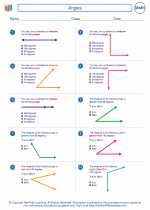
 Worksheet/Answer key
Worksheet/Answer key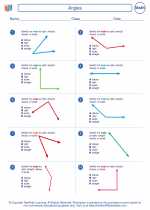
 Worksheet/Answer key
Worksheet/Answer key
 Worksheet/Answer key
Worksheet/Answer key
 Worksheet/Answer key
Worksheet/Answer key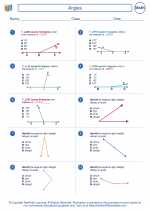
 Worksheet/Answer key
Worksheet/Answer key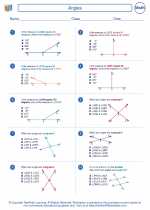
 Worksheet/Answer key
Worksheet/Answer key
 Worksheet/Answer key
Worksheet/Answer key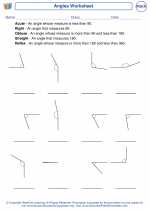
 Worksheet/Answer key
Worksheet/Answer key
 Worksheet/Answer key
Worksheet/Answer key